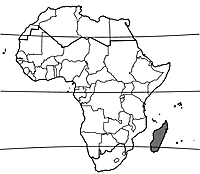Colubrina decipiens (PROTA)
Introduction |
| General importance | |
| Geographic coverage Africa | |
| Geographic coverage World | |
| Essential oil / exudate | |
| Timber | |
Colubrina decipiens (Baill.) Capuron
- Protologue: Adansonia, sér. 2, 6: 127 (1966).
- Family: Rhamnaceae
Synonyms
- Macrorhamnus decipiens Baill. (1874).
Origin and geographic distribution
Colubrina decipiens is endemic to western Madagascar.
Uses
The wood, known as ‘tratramborondreo’ or ‘malamasafoy’ in Madagascar, is used for construction, parquet flooring, joinery, interior trim, railway sleepers and furniture. The bark rubbed in water is used as a soap substitute.
Properties
The heartwood is dark brown with faint streaks, and distinctly demarcated from the sapwood. The texture is medium. The wood is medium-weight to fairly heavy, with a density of 700–850 kg/m³ at 12% moisture content, and hard. It usually air dries satisfactorily. The rates of shrinkage during drying are moderately high. Once dry, the wood is moderately stable in service. The heartwood is fairly durable and moderately resistant to impregnation with preservatives.
Description
- Deciduous shrub or small to medium-sized tree up to 20(–25) m tall; bole up to 65(–90) cm in diameter; bark surface smooth but scaly, grey to blackish with distinct greyish patches; crown open, irregularly spreading; twigs reddish brown hairy.
- Leaves opposite, simple and entire; stipules up to 6 mm long, early caducous; petiole 1–2 cm long; blade ovate to ovate-lanceolate, (2.5–)6–12 cm × (1.5–)2.5–6 cm, base obtuse to rounded or shallowly cordate, apex obtuse to acuminate, nearly glabrous, with translucent dots, 3–5-veined from the base and additionally with a few pairs of lateral veins.
- Inflorescence a short, axillary cyme, with short peduncle, densely reddish brown hairy.
- Flowers bisexual, regular, 5-merous; pedicel 2.5–3.5 mm long; calyx lobes triangular, c. 2 mm × 2 mm; petals hood-shaped, nearly 2 mm long; stamens free, each stamen partly enveloped by a petal; disk flat, glabrous, covering the ovary; ovary for the greater part superior, 3-celled, style c. 0.5 mm long, with 3 short lobes.
- Fruit a nearly globose to ovoid capsule 8–15 mm long, with short cup at base, glabrous, yellow, later becoming brownish black, splitting into three 1-seeded parts, each opening with a slit.
- Seeds c. 5 mm long, slightly compressed, dark brown to blackish, with small aril at base.
- Seedling with hypogeal germination.
Other botanical information
Colubrina decipiens grows moderately rapidly, with an average annual height increment of 45 cm and a mean annual bole diameter increment of 5 mm. Trees are usually leafless from July to October and they flower around December. Fruits take 4–5 months to ripen.
Colubrina comprises about 30 species occurring throughout the warmer parts of the world. In Madagascar 6 species occur, of which one (Colubrina asiatica (L.) Brongn.) also occurs along the coasts of East Africa.
Ecology
Colubrina decipiens occurs in dry deciduous forest, from sea-level up to 600(–800) m altitude. The mean annual rainfall in the distribution area is 300–700(–1000) mm, with 5–7 (–9) dry months, and the mean annual temperature is 25°C. Colubrina decipiens is often found on more humid localities and it tolerates temporary inundation. It seems to prefer limestone soils.
Management
Ripe fruits can be collected from the ground. They should be immersed in water for 3–4 days and subsequently dried in the sun until they open. The 1000-seed weight is 2–3 g. The germination rate of seeds is 25–40%. Seeds can be stored for up to one year without losing much of their germination power. They are sown in seed beds or in pots, usually in January, and seedlings are ready for transplanting into the field when they are one year old and about 50 cm tall. They are usually planted bare-rooted and in the full sun.
Genetic resources
Colubrina decipiens is widespread throughout western Madagascar and locally common, and there are no indications that it is in danger of genetic erosion.
Prospects
Colubrina decipiens seems to have fair prospects as a plantation tree and for enrichment planting in the dry forests of western Madagascar. However, long cutting cycles are probably needed to obtain boles large enough to be suitable for sawn timber production.
Major references
- Blaser, J., Rajoelison, G., Tsiza, G., Rajemison, M., Rabevohitra, R., Randrianjafy, H., Razafindrianilana, N., Rakotovao, G. & Comtet, S., 1993. Choix des essences pour la sylviculture à Madagascar. Akon’ny Ala: Bulletin du Département des Eaux et Forêts 12–13. 166 pp.
- CFPF (Centre de Formation Professionelle Forestière), 2008. Fiches techniques: version francaise. Centre de Formation Professionelle Forestière, Morondova, Madagascar. 14 pp.
Other references
- Johnston, M.C., 1971. Revision of Colubrina (Rhamnaceae). Brittonia 23(1): 2–53.
- Perrier de la Bâthie, H., 1950. Rhamnacées (Rhamnaceae). Flore de Madagascar et des Comores (plantes vasculaires), famille 123. Firmin-Didot et cie., Paris, France. 51 pp.
- Schatz, G.E., 2001. Generic tree flora of Madagascar. Royal Botanic Gardens, Kew, Richmond, United Kingdom. 477 pp.
Author(s)
- R.H.M.J. Lemmens, PROTA Network Office Europe, Wageningen University, P.O. Box 341, 6700 AH Wageningen, Netherlands
Correct citation of this article
Lemmens, R.H.M.J., 2011. Colubrina decipiens (Baill.) Capuron. [Internet] Record from PROTA4U. Lemmens, R.H.M.J., Louppe, D. & Oteng-Amoako, A.A. (Editors). PROTA (Plant Resources of Tropical Africa / Ressources végétales de l’Afrique tropicale), Wageningen, Netherlands.
Accessed 5 April 2025.
- See the Prota4U database.

